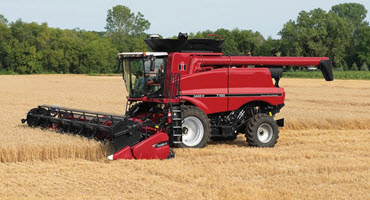The 150 series features design elements from the first Axial-Flow combine
By Diego Flammini
Staff Writer
Farms.com
A new series of Case IH combines pays homage to the equipment’s past while filling the needs of today’s commercial farmers.
Combines in the Case IH 150 heritage series will be available for 2019, which is the 42nd anniversary of the first Axial-Flow machines.
“When the Axial-Flow combine was launched in 1977, they had a white roof cap, white rims and an IH logo on the side,” Kelly Kravig, Case IH 150 series product manager, told Farms.com today. “We have a number of producers who remember the original 1400 series Axial-Flow, and our new 150 series machines will have those same design elements as a nod to the past.”

But while the look may be from the past, the combines feature state-of-the-art technology.
Combines in the 150 series can harvest up to 5,000 bushels of grain per hour.
They also come equipped with a two-speed electric shift transmission. This allows farmers greater control when using the machine in the field or on the road.
“With the two-speed, we have a hi-low propulsion system that allows producers to shift in the field,” Kravig said. “So, depending on the conditions they’re in, they can select the appropriate speed for the operation.”
The combines also feature a Cross Flow cleaning system.
The fan speed and configuration can increase productivity by nearly 20 percent, Kravig said.
“A traditional cleaning system oscillates in an elliptical motion,” he said. “Cross flow technology compensates for side hills and slopes and oscillates side to side. That helps farmers handle rolling ground and terrain easier, harvest more efficiently and save more grain.”
Operators of the new 150 series will also be able to better manage their residue.
The three combines in the series come with either a three-bladed discharge beater, a standard cut straw chopper or a six-row flail cut chopper.
Farmers can vary spreader speed from inside the cab and tailor the spread pattern based on factors like wind conditions, Kravig said.